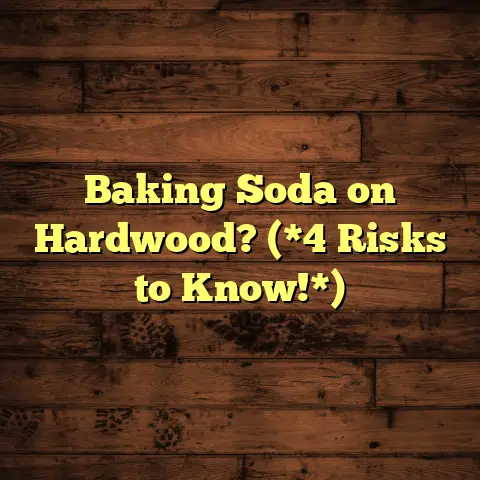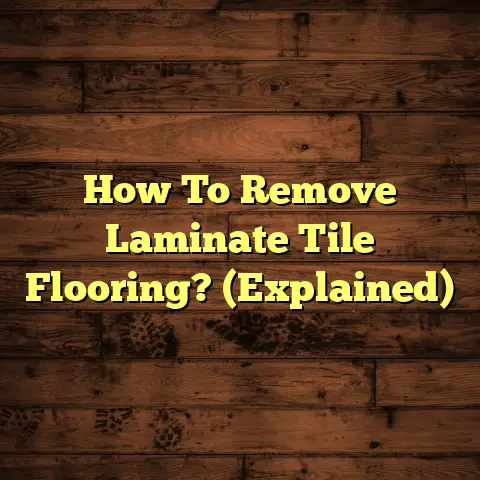Vinegar Hurt Hardwood? (3 Damage Indicators!)
And let me tell you, I’ve seen it all when it comes to hardwood floors.
From water damage to pet accidents, and everything in between.
But one culprit that often surprises people is something they think is harmless: vinegar.
Did you know that around 54% of homeowners in America choose hardwood for its beauty and durability?
It’s a fantastic choice, no doubt.
But it needs the right care.
Today, we’re diving deep into whether vinegar can actually hurt your hardwood floors.
Spoiler alert: it can.
Let’s explore the 3 main damage indicators to watch out for.
I. Understanding Hardwood Flooring
1. Definition and Types of Hardwood Flooring
So, what is hardwood flooring exactly?
Well, it’s flooring made from a single piece of wood, typically from deciduous trees like oak, maple, or walnut.
Think of it as the “real deal” of flooring.
There are two main types:
- Solid Hardwood: This is a single piece of wood from top to bottom. It’s durable and can be refinished multiple times.
-
Engineered Hardwood: This consists of a thin layer of real hardwood bonded over a core of plywood or fiberboard.
It’s more resistant to moisture and temperature changes.
The materials used in hardwood floors are chosen for their hardness, grain patterns, and overall aesthetic appeal.
Oak is popular for its durability and classic look.
Maple is known for its smooth, uniform grain.
And walnut offers a rich, dark color.
2. Popularity and Maintenance
Why is hardwood so popular?
Well, it adds a touch of elegance and warmth to any home.
Plus, it’s durable and can last for decades with proper care.
According to the National Wood Flooring Association (NWFA), hardwood floors can increase a home’s resale value.
Now, let’s talk maintenance.
To keep your hardwood floors looking their best, you need to:
- Sweep or vacuum regularly: This removes dirt and debris that can scratch the finish.
- Use a damp mop (not wet!) with a pH-neutral cleaner: Avoid harsh chemicals.
- Clean up spills immediately: Liquids can seep into the wood and cause damage.
- Use rugs in high-traffic areas: This protects the finish from wear and tear.
II. The Role of Vinegar in Household Cleaning
1. Vinegar as a Cleaning Agent
Vinegar is a solution of acetic acid in water.
It’s a common household item used for everything from cooking to cleaning.
Many people swear by it as a natural and effective cleaner.
But why?
Well, the acetic acid in vinegar can help dissolve dirt, grease, and mineral deposits.
It’s also a natural disinfectant.
You can use vinegar to:
- Clean windows and mirrors
- Deodorize your garbage disposal
- Remove hard water stains
- Clean coffee makers
2. Common Misconceptions
Here’s where things get tricky.
There’s a common misconception that vinegar is a safe and effective cleaner for all surfaces.
And that’s simply not true.
While vinegar is great for some cleaning tasks, it can actually damage certain materials, including hardwood floors.
The problem is its acidity.
Which brings us to the next section…
III. The Impact of Vinegar on Hardwood Floors
1. Acidity and Its Effects
Vinegar has a pH of around 2-3.
This means it’s acidic.
The pH scale ranges from 0 to 14.
With 7 being neutral.
Substances with a pH below 7 are acidic, and those above 7 are alkaline.
The acidity of vinegar can break down the finish on hardwood floors over time.
This can lead to discoloration, dulling, and even surface damage.
Think of it like this: your hardwood floor’s finish is like a protective shield.
Vinegar, with its acidic properties, slowly eats away at that shield.
2. Indicators of Damage
Okay, so how do you know if vinegar has hurt your hardwood floors?
Here are 3 key damage indicators to watch out for:
A. Indicator 1: Discoloration
Discoloration is one of the first signs that vinegar is taking its toll.
Vinegar can cause fading, staining, or an overall change in the color of your wood.
I’ve seen floors where the areas cleaned with vinegar became noticeably lighter or more yellowed than the rest.
This happens because the acid in vinegar reacts with the wood’s finish, altering its pigment.
Sometimes, you might see distinct stains or spots where vinegar was spilled or applied.
These stains can be difficult to remove and may require professional refinishing to correct.
Visual Examples/Case Studies:
I remember one client who regularly used a vinegar and water solution to clean her oak floors.
Over time, she noticed that the floors were losing their rich, warm color and becoming dull and faded.
When I inspected the floors, I could clearly see the discoloration, especially in high-traffic areas.
We ended up having to refinish the entire floor to restore its original beauty.
Another example is a homeowner who spilled vinegar while cooking and didn’t clean it up immediately.
The next day, they found a dark stain on their maple floor that wouldn’t come out, no matter how hard they tried.
These are just a couple of examples of how vinegar can cause discoloration and ruin the look of your hardwood floors.
B. Indicator 2: Dulling of Finish
Another telltale sign of vinegar damage is a loss of luster and shine.
Hardwood floors are known for their beautiful, glossy finish.
But repeated exposure to vinegar can make them look dull and lifeless.
The acid in vinegar breaks down the protective layers of the finish, leaving the wood vulnerable to scratches and wear.
A dulled finish not only affects the aesthetics of your floors.
But also reduces their ability to protect the wood from moisture and other damage.
A healthy finish acts as a barrier, preventing liquids from seeping into the wood and causing it to warp or rot.
When the finish is compromised, your floors become more susceptible to water damage, stains, and other problems.
Implications of a Dulled Finish:
A dulled finish can make your floors look old and worn, even if they’re relatively new.
It can also make them harder to clean, as dirt and grime can easily get trapped in the damaged finish.
Plus, a dulled finish can reduce the resale value of your home.
Buyers are often turned off by floors that look neglected or damaged.
C. Indicator 3: Surface Damage
In severe cases, vinegar can actually cause physical damage to the wood itself.
This can include surface scratches, etching, or wear.
The acid in vinegar can slowly dissolve the top layers of the wood, creating tiny pits or grooves.
Over time, these small imperfections can become more noticeable and affect the overall appearance of your floors.
I’ve even seen cases where vinegar has caused the finish to peel or flake off, exposing the bare wood underneath.
This is especially common in areas where vinegar is frequently used or where spills are left to sit for extended periods.
Expert Opinions/Research Findings:
According to a study by the Forest Products Laboratory, acidic substances like vinegar can weaken the cell structure of wood.
Making it more susceptible to damage from abrasion and impact.
The NWFA also warns against using vinegar on hardwood floors, recommending pH-neutral cleaners instead.
IV. Long-Term Consequences of Vinegar Damage
1. Durability and Longevity
Vinegar damage can significantly affect the overall lifespan of your hardwood flooring.
By breaking down the finish and weakening the wood, vinegar can make your floors more vulnerable to wear and tear.
This can lead to premature aging and the need for more frequent repairs or refinishing.
In extreme cases, vinegar damage can even necessitate complete floor replacement.
Which is a costly and time-consuming undertaking.
Potential Need for Refinishing or Replacement:
Refinishing involves sanding down the existing finish and applying a new coat of sealant.
This can restore the look of your floors and protect them from further damage.
However, refinishing can be expensive.
And it’s not always possible if the wood is too thin or damaged.
In such cases, replacement may be the only option.
2. Financial Implications
Repairing or replacing damaged hardwood floors can be a costly endeavor.
The exact cost will depend on the extent of the damage, the type of wood, and the size of the area that needs to be fixed.
But you can expect to spend hundreds or even thousands of dollars to restore your floors to their original condition.
Statistics/Case Studies:
According to HomeAdvisor, the average cost to refinish hardwood floors is between \$3 and \$8 per square foot.
For a 200-square-foot room, that could be anywhere from \$600 to \$1,600.
Replacing hardwood floors is even more expensive.
With costs ranging from \$6 to \$12 per square foot.
That same 200-square-foot room could cost you \$1,200 to \$2,400 to replace.
These costs don’t even include the cost of labor.
Which can add hundreds or even thousands of dollars to the total.
V. Conclusion
So, there you have it.
Vinegar, while a popular and versatile cleaning agent, can actually hurt your hardwood floors.
The acidity of vinegar can lead to discoloration, dulling of the finish, and even surface damage.
Over time, this can affect the durability and longevity of your floors, leading to costly repairs or replacement.
I urge you to reconsider your cleaning practices.
Especially when it comes to using vinegar on hardwood surfaces.
Opt for pH-neutral cleaners specifically designed for hardwood floors.
And always follow the manufacturer’s instructions.
Your floors will thank you for it!
Remember, a little bit of prevention can go a long way in protecting your investment and keeping your hardwood floors looking beautiful for years to come.





